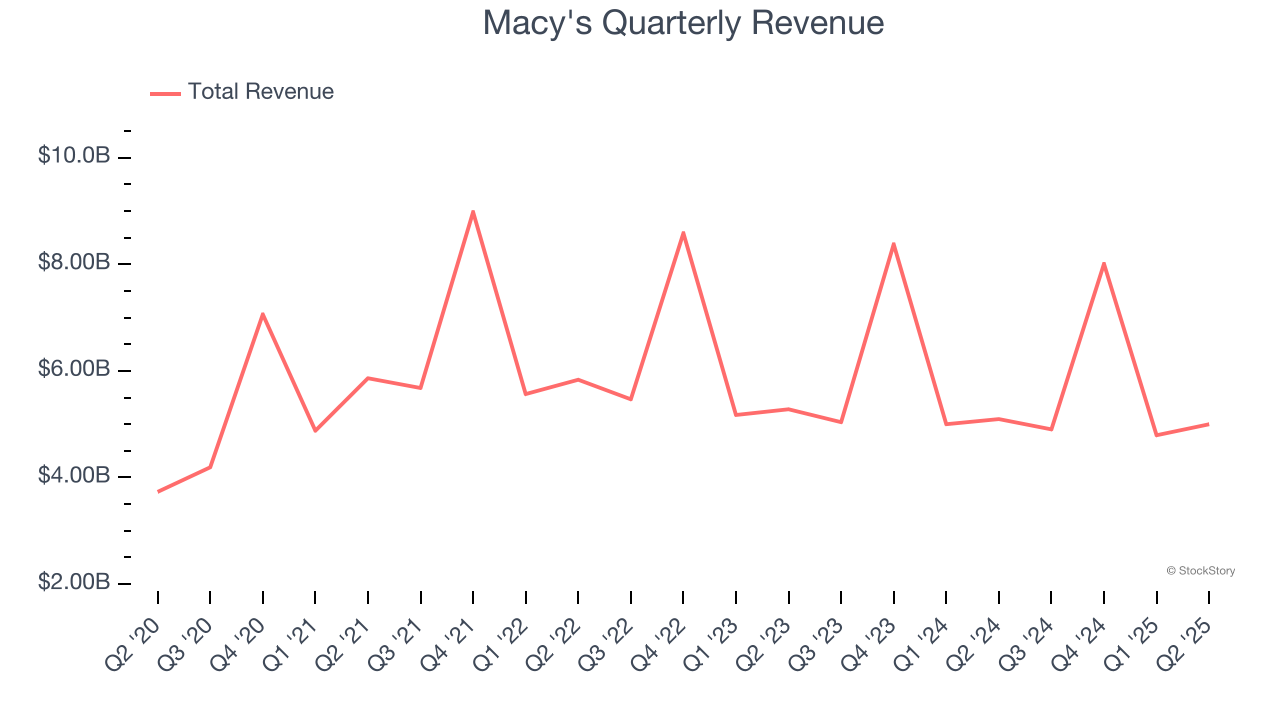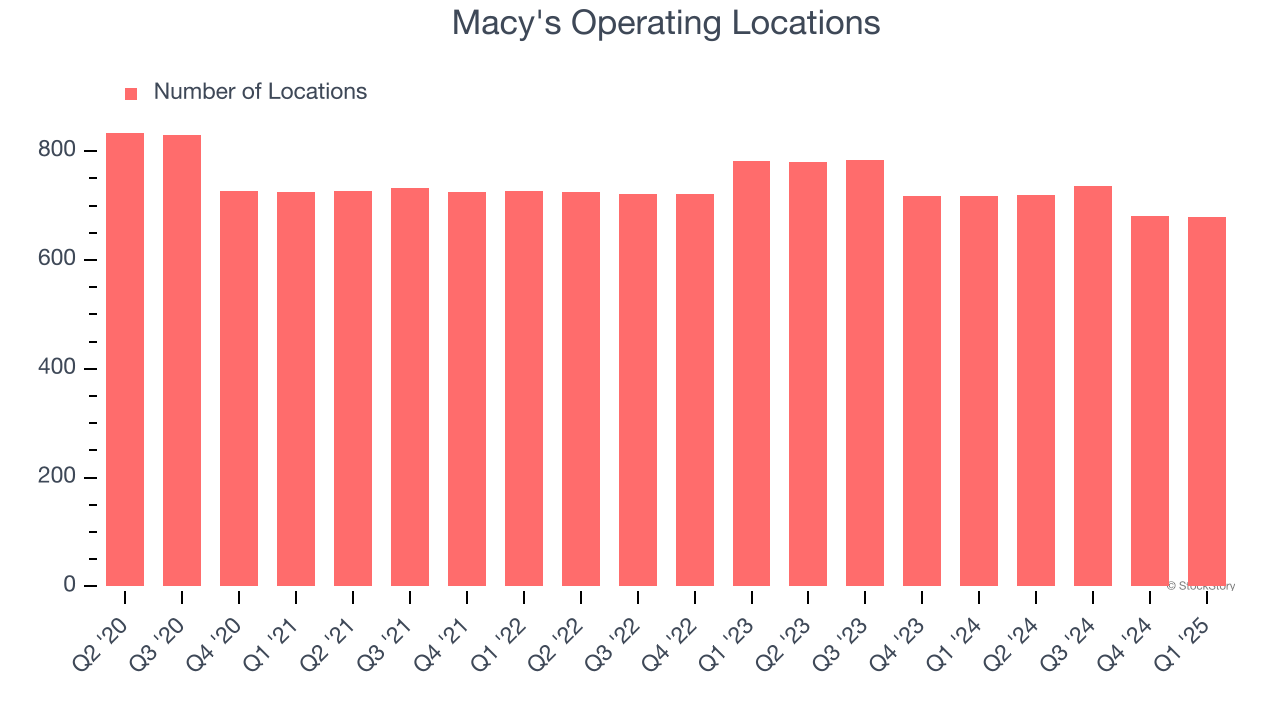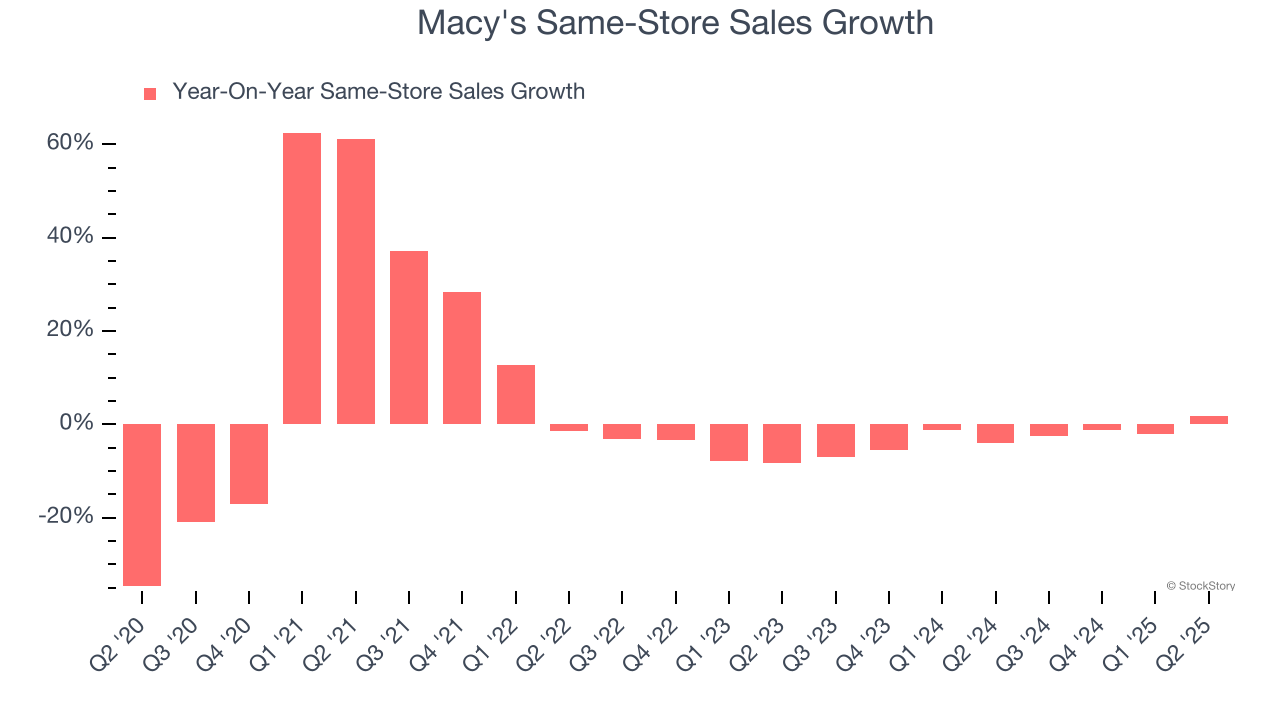
Department store chain Macy’s (NYSE: M) beat Wall Street’s revenue expectations in Q2 CY2025, but sales fell by 1.9% year on year to $5.00 billion. The company’s full-year revenue guidance of $21.3 billion at the midpoint came in 0.6% above analysts’ estimates. Its non-GAAP profit of $0.41 per share was significantly above analysts’ consensus estimates.
Is now the time to buy Macy's? Find out by accessing our full research report, it’s free.
Macy's (M) Q2 CY2025 Highlights:
- Revenue: $5.00 billion vs analyst estimates of $4.87 billion (1.9% year-on-year decline, 2.7% beat)
- Adjusted EPS: $0.41 vs analyst estimates of $0.19 (significant beat)
- Adjusted EBITDA: $393 million vs analyst estimates of $312.5 million (7.9% margin, 25.8% beat)
- The company slightly lifted its revenue guidance for the full year to $21.3 billion at the midpoint from $21.2 billion
- Management raised its full-year Adjusted EPS guidance to $1.88 at the midpoint, a 4.2% increase
- Operating Margin: 3%, down from 4.4% in the same quarter last year
- Free Cash Flow was $153 million, up from -$195 million in the same quarter last year
- Same-Store Sales rose 1.9% year on year (-4% in the same quarter last year)
- Market Capitalization: $3.66 billion
“Our teams achieved better than expected top- and bottom-line results during the second quarter, driven by our strongest comparable sales growth in 12 quarters, reflecting the strong performance in Macy’s Reimagine 125 locations, Bloomingdale’s and Bluemercury,” said Tony Spring, chairman and chief executive officer of Macy’s,
Company Overview
With a storied history that began with its 1858 founding, Macy’s (NYSE: M) is a department store chain that sells clothing, cosmetics, accessories, and home goods.
Revenue Growth
A company’s long-term sales performance can indicate its overall quality. Any business can put up a good quarter or two, but many enduring ones grow for years.
With $22.7 billion in revenue over the past 12 months, Macy's is one of the larger companies in the consumer retail industry and benefits from a well-known brand that influences purchasing decisions. However, its scale is a double-edged sword because it’s harder to find incremental growth when you’ve penetrated most of the market. For Macy's to boost its sales, it likely needs to adjust its prices or lean into foreign markets.
As you can see below, Macy’s revenue declined by 2% per year over the last six years (we compare to 2019 to normalize for COVID-19 impacts) as it closed stores and observed lower sales at existing, established locations.

This quarter, Macy’s revenue fell by 1.9% year on year to $5.00 billion but beat Wall Street’s estimates by 2.7%.
Looking ahead, sell-side analysts expect revenue to decline by 4.6% over the next 12 months, a slight deceleration versus the last six years. This projection is underwhelming and implies its products will see some demand headwinds.
Unless you’ve been living under a rock, it should be obvious by now that generative AI is going to have a huge impact on how large corporations do business. While Nvidia and AMD are trading close to all-time highs, we prefer a lesser-known (but still profitable) stock benefiting from the rise of AI. Click here to access our free report one of our favorites growth stories.
Store Performance
Number of Stores
Macy's has generally closed its stores over the last two years, averaging 3.5% annual declines.
When a retailer shutters stores, it usually means that brick-and-mortar demand is less than supply, and it is responding by closing underperforming locations to improve profitability.
Note that Macy's reports its store count intermittently, so some data points are missing in the chart below.

Same-Store Sales
A company's store base only paints one part of the picture. When demand is high, it makes sense to open more. But when demand is low, it’s prudent to close some locations and use the money in other ways. Same-store sales provides a deeper understanding of this issue because it measures organic growth at brick-and-mortar shops for at least a year.
Macy’s demand has been shrinking over the last two years as its same-store sales have averaged 2.7% annual declines. This performance isn’t ideal, and Macy's is attempting to boost same-store sales by closing stores (fewer locations sometimes lead to higher same-store sales).

In the latest quarter, Macy’s same-store sales rose 1.9% year on year. This growth was a well-appreciated turnaround from its historical levels, showing the business is regaining momentum.
Key Takeaways from Macy’s Q2 Results
It was good to see Macy's beat analysts’ EPS expectations this quarter. We were also excited its full-year revenue and EPS guidance were both raised. Zooming out, we think this was a very solid print. The stock traded up 11.4% to $15.04 immediately after reporting.
Sure, Macy's had a solid quarter, but if we look at the bigger picture, is this stock a buy? The latest quarter does matter, but not nearly as much as longer-term fundamentals and valuation, when deciding if the stock is a buy. We cover that in our actionable full research report which you can read here, it’s free.






